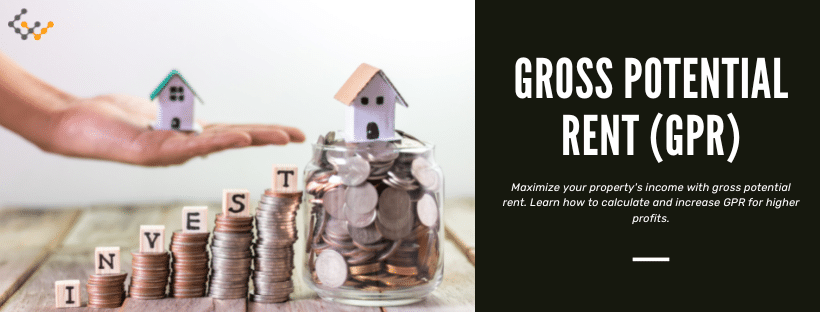Understanding Gross Potential Rent

Investors considering the purchase of a real estate for rental purposes must determine the estimated value of that property. One component of that process is to evaluate the potential income a property can offer. This is where the gross potential rent formula is helpful.
What is Gross Potential Rent?
Gross potential rent is a metric that investors use to determine the amount of expected income a property could produce when rented. It is the total amount of rental income possible from that property, assuming that the property is at full rental capacity with all units rented. It factors in market rates. It also depends on all property tenants making payments as expected.
The key here is the word “potential.” GPR is the maximum amount of rental income that an investor or property holder can expect to generate from the property. However, it assumes full rental at the highest level. It assumes that the property could be rented at full market rent and that the tenants will make payments reliably. If any of these factors are inaccurate or change over time, the rent is not guaranteed, nor can it be expected.
Answer a few questions and get custom mortgage quotes. We'll match you with offers from our network of 650+ lenders.
How to Calculate Gross Potential Rent for a Property
The gross potential rental formula is straightforward. Follow this potential gross income formula for any property being considered.
- Determine the number of rentable units in the property.
- Evaluate market conditions to determine the current market rent for that type of property per month.
- Multiply the number of units by the market rent per unit.
- This produces a monthly figure. Multiply that by 12 for an annual GPR.
This figure can also be used based on the number of square feet rentable for the property rather than units. For example, if a building has 100,000 square feet of rental space, that could be spread over 15 units. Overall, the GPR per square foot is determined based on the market rent by the square foot. If that is $10 per square foot, this property produces $1 million if all property is rented and tenants make payments on time. This could be a potential gross rent multiplier (square footage rather than units).
Example of How GPR Is Calculated
To calculate gross potential rent, consider the following.
A property has 12 units available to rent. Each unit has a market rent value of $10,000 each month. In this situation, 12 multiplied by $10,000 equals $120,000 per month in potential gross rent each month. Multiply that by 12 again (for the number of months in a year) to determine the annual figure, which in this situation is $1.440 million.
This assumes all 12 units are rented, and all tenants are making payments on time.
3 Factors That Influence Gross Potential Rent
Though gross potential rent is a very specific figure, it is dependent on all elements being equal. That means various factors can influence how accurate the result is when calculating gross potential rent. For example, the following are some key factors that impact reaching the GPR expected:
- The current market rent in the area must be accurate. However, slight differences when comparing one property to the other, such as location and surroundings, can alter GPR.
- If a tenant fails to make payment on time, that impacts the accuracy of GPR.
- Changes in tenants could also impact GPR if one is not as reliable as the other.
Any change to market conditions can also impact the ability to collect the expected GPR. Economic and local political factors could play a role in the viability of a property. The financial health of those occupying commercial properties can also matter.
To provide a better estimate of the overall value of a property then, investors typically need to look at the trailing twelve months, or TTM, to determine the GPR. Additionally, the trailing three months (T3) is also a factor that must be considered to determine profitability. In this situation, GPR in real estate is based on current figures rather than guesses on what the property is worth. However, in situations where the current property is not rented to full value, looking at TTM or TT3 may be less accurate.
Gross Potential Rent (GPR) vs Gross Potential Income (GPI)
Gross potential rent and gross potential income can differ, and both are equally important for investors to consider. GPI refers to the amount of income a property generates when it is fully rented. The difference in GPI is that it includes other income that may go beyond just rental payments.
For example, GPR only factors in rental payments paid by tenants. GPI will include rental income as well as other non-rentable income from the property. This could include income from parking space rental, onsite laundry costs, membership fees, or other additional costs that are expected to be paid by tenants or others using the property.
Gross Potential Rent (GPR) vs Market Rent
When calculating gross potential rent, the market rent of the area is determined. Market rent is the average amount of rent that the tenants in the area pay for properties that are much like the current property. That is, to calculate GPR, investors must look for other properties in the area offering the same size, features, locations, or other elements that help to give them some idea of what the monthly rent they could charge is. The market rent needs to be accurate for GPR in real estate to be accurate. ‘
To use the potential gross income formula, investors must take into consideration the actual rent charged to other properties nearby that are similar in fashion. Differences in size, location, use, and features can alter what market rent is. Gross potential rent vs market rent is a key factor to consider when estimating the value of any property investment.
How to Maximize Gross Potential Rent
While calculating gross potential rent relies on the accuracy of expectations, there could be some ways for investors to maximize what they earn and their ability to reach this expected figure.
For example, properly screening tenants to ensure they are qualified to make payments on time every month is a core factor to consider. It is also essential to ensure that the property is fully rented, which requires ensuring accurate marketing to fill available locations.
Gross potential rent vs market rent is the core component here. If the market rent is not accurate, the resulting GPR will not be accurate either. It assumes that the property nearby is equal to that of the investment property. If the investment property is smaller, perhaps harder to see from the street, or is otherwise less desirable, then that limits market rent, impacting the overall ability to reach accurate GPR.
Wrapping Things Up
GPR is one financial metric that investors need to use to determine the amount of profit a building or other space can offer to them. GPR is dependent on accurate figures, including an accurate estimate of local market rent, full leasing of the property, and on time payments. Small adjustments here can lead to limitations in accuracy. However, when done well, GPR can help investors to evaluate how well a property fits their financial needs and goals based on the amount of rent it can potentially generate.

